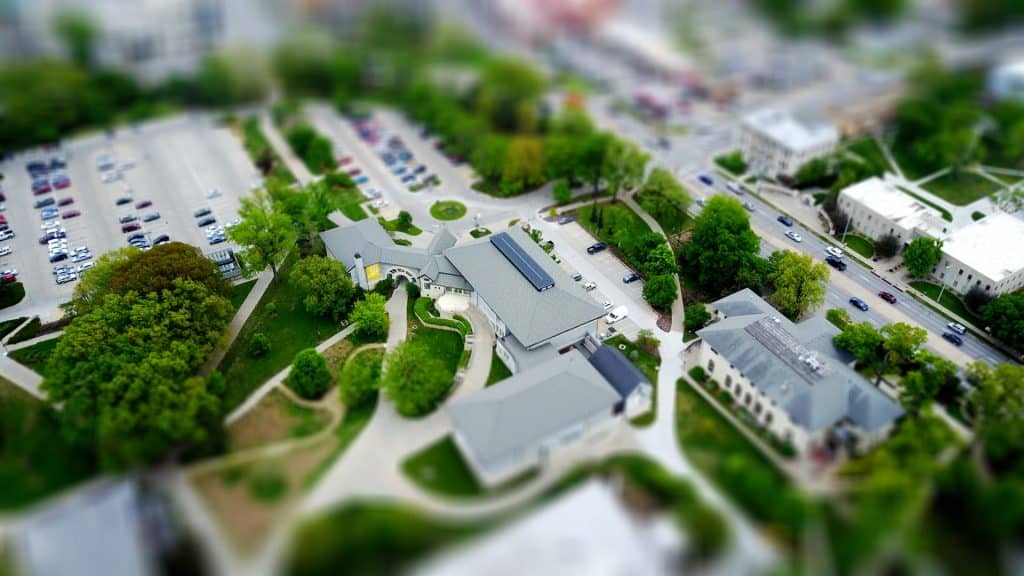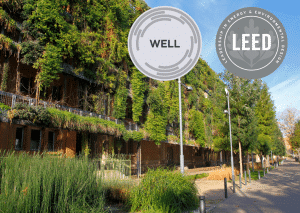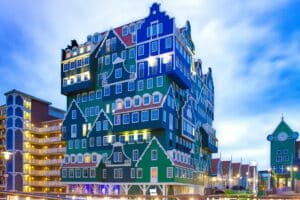In today’s time and age when people are becoming increasingly aware about energy efficiency and sustainability of the built environment, it is rare to come across a modern building that does not employ an efficient and reliable management system capable of ensuring the safety, health and comfort of the people living/working inside its premises, along with effective maintenance and optimization of resources used.
This is where Building Management System comes in.
What is a Building Management System (BMS)?
A building management system (BMS) is a control system that can be used to monitor and manage the mechanical, electrical and electromechanical services in a facility. Such services can include power, heating, ventilation, air-conditioning, physical access control, pumping stations, elevators and lights.
A very basic BMS consists of software, a server with a database and smart sensors connected to an Internet-capable network. Smart sensors around the building gather data and send it to the BMS, where it is stored in a database. If a sensor reports data that falls outside pre-defined conditions, the BMS will trigger an alarm. In a data center, for example, the BMS might trigger an alarm when the temperature in a server rack exceeds acceptable limits.
Depending on the system, BMS software can be installed as a standalone application or it can be integrated with other monitoring programs. More advanced BMSes can monitor and manage a wide range of building services across multiple platforms and protocols, providing facility administrators with a single, shared view of the facility’s operations.
#1 LEED Exam Prep now available with money back guarantee. Pass the LEED Exam like a Pro. Register Today!
Major Components of a Building Management System
The primary function of building management systems is most often to control the HVAC, heating, and ventilation systems, but there are other functions as well. The main components of a building management system and their basic functionalities are as follows:
- Boiler controls—maintain a constant temperature and switch boilers on/off at certain times.
- HVAC—maintain a specified air state with regard to temperature and humidity; control fans and dampers; control air handling units and fan coil units.
- Lighting control—turn lights on/off according to a specified schedule.
- Electric power control—control and monitor core electrical and mechanical equipment.
- Heating—schedule the system on and off; maintain a set temperature point.
- Ventilation—adjust the ventilation based on occupancy controls.
- Security and observation—access control; surveillance and intrusion detection.
- Fire alarm system—smoke control system; active alarm locations.
- Elevators—elevator video display; status system.
- Plumbing and water monitoring—detect hydraulic flows; open/close valves automatically; monitor/observe temperature deviations.
Many building management systems have additional capabilities and features; some can even be designed specifically for the facility itself. Typically these types of systems use a combination of hardware and software to monitor and manage, including a central server or servers, monitoring stations (for systems administrators), and remote sensors, as well as software that allows you to interact with the system.
Types of BMS
There are two basic types of BMS:
- Monitoring and targeting systems – These are designed to monitor energy use and target areas for improvement.
- Continuous commissioning systems – These systems adjust your HVAC and other systems continuously to meet demand.
Difference between Building Management System (BMS) and Building Energy Management System (BEMS)
The phrase Building Energy Management Systems is sometimes used interchangeably with Building Management Systems (BMS), however, strictly speaking, Building Management Systems can be used to monitor and control a wide range of building systems whereas Building Energy Management Systems relate specifically to energy-related systems such as HVAC, lighting and power systems.
Benefits of Building Management System (BMS)
Right from significantly reducing operational costs to offering intensive security solutions, BMS provides a host of benefits, some of which are listed below.
- BMS helps you become energy-efficient through minimizing energy usage and waste. This is because this system uses powerful tools and energy information which can be used to limit and measure energy wastage. For example, switching off the lights in the evening or responding to changes in the environment, such as turning down the heating if it gets warmer outside.
- BMS controls up to more than 80% of your building’s energy usage. It monitors the usage patterns and lets you know when the demand for energy is at its peak so that you can attempt to use less energy. This not only proves to be cost effective but is also great for the planet.
- BMS has been designed to offer safety for your building, its occupants, and your business assets. For example, automatic opening of shutters when fire is detected facilitates building access for the firefighters and opens additional evacuation routes. Redirecting CCTV cameras towards the location of the fire detector helps determining a suitable fire-fighting strategy before accessing the area.
- BMS aims to keep your indoor environment safe and comfortable through an efficiently working HVAC system. Since this system keeps temperature at a comfortable level, it results in less stress issues and has a positive impact on the overall well-being of the building’s inhabitants.
Checkout: Advances in HVAC Technology: What’s New?
- For many businesses, ‘system down time’ is not acceptable e.g. Data Centers, Hospitals and Factories. Therefore systems need to be robust and reliable and able to adapt or expand with business needs. BMS critical alarms detect if something is serious that needs attention, before you experience downtime.
- BMS provides various sustainable solutions to your building infrastructure and the environment. It also helps conserve the precious natural resources.
- BMS has an intensive security operation in place to prevent criminal activity, employee theft, tampering or damage to your property.
- In addition to all the above mentioned benefits, a building that uses BMS has an increased value in the market.
What is sustainability?
Sustainability has often been defined as how biological systems endure and remain diverse and productive. But, the 21st-century definition of sustainability goes far beyond these narrow parameters. Today, it refers to the need to develop the sustainable models necessary for both the human race and planet Earth to survive.
Sustainability is a balancing act. The United Nation’s 1987 Report of the World Commission on Environment and Development: Our Common Future noted that “sustainable development meets the needs of the present without compromising the well-being of future generations.”
A sustainable society is founded on equal access to health care, nutrition, clean water, shelter, education, energy, economic opportunities and employment. In this ideal society, humans live in harmony with their natural environment, conserving resources not only for their own generation, but also for their children’s children. Each citizen enjoys a high quality of life and there is social justice for all.
Now amid all the gloom surrounding the future, the promise of science shines brightly. Optimists hope that new technologies and urban infrastructures, built with environmentally sound practices, can support a sustainable, healthy and happy population.
Sustainable architecture designs and constructs buildings in order to limit their environmental impact, with the objectives of achieving energy efficiency, positive impacts on health, comfort and improved livability for inhabitants; and all of this is achieved through the implementation of appropriate technologies within the building.
Also Read:
- Sustainability & Scarcity: Green Design & Construction in the World’s Least Developed Regions
- Namaste LEED: Sustainability, Green Building & LEED [Student Edition]
- Sustainability Consulting: What, How and Lessons Learned
Sustainability in the Built Environment
Sustainable design is a collective process whereby the built environment achieves unprecedented levels of ecological balance through new and retrofit construction, with the goal of long-term viability and humanization of architecture.
Sharlyn Underwood, American Society of Interior Designers (ASID) Virginia chapter president and interior designer with Smith Lewis Architecture, defines sustainable design in the architectural sector this way: “Sustainable design is the practice of designing buildings so that they exist in harmony with natural systems.”
Focusing on the environmental context, sustainable design merges the natural, minimum resource conditioning solutions of the past (daylight, solar heat, and natural ventilation) with the innovative technologies of the present. The desired result is an integrated “intelligent” system that supports individual control with expert negotiation for resource consciousness.
In simple terms, sustainable design is the intention to reduce or completely eliminate negative environmental impacts through thoughtful designs in the built environment. A sustainable design will seek to incorporate environmentally-preferable outcomes such as:
- Lower energy and water consumption through the entire building lifecycle – from construction to operation to demolition
- Minimize impact on climate change by reducing greenhouse gas emissions or mitigating them through carbon neutralizing activities
- Limit resource consumption through waste-free manufacturing, a preference for renewable resources, and an emphasis on recycled materials
- Reduce or eliminate waste by minimizing consumption, reusing when possible, and recycling when necessary
- Minimize impact on the local ecosystem and look for ways to incorporate biomimicry principles where possible
- Give preference to non-toxic building materials and those that will contribute to the health and wellbeing of humanity
- Emphasize quality and durability over price
BMS and Sustainable Built Environment
The biggest challenge faced by the building and construction sector is to achieve sustainability in the built environment. From this dimension, effective use of Building Management System (BMS) plays a significant role in bringing an element of sustainability in the built environment.
Higher energy efficiency, lower operating and maintenance costs, better indoor air quality, greater occupant comfort and productivity are the major achievements of a successful BMS.
In fact, a BMS allows complete control of all facility lighting for common areas, podiums, parking, facade lighting and landscaping. It allows control of water pumps and monitoring of water tank status. It can monitor the status of a variety of sub-systems that need constant vigil at the building level such as generators, STP plants, elevators and more. Energy consumption monitoring, especially for the energy consumption devices without using sub-metering is one of the key features of BMS system. This enables your building to become more resource-efficient.
Further, a facility’s systems run more efficiently when controlled by a BMS which prevents breakdowns and other issues, especially within HVAC systems. When controlled by a BMS, a building’s systems tend to experience less wear and tear, and therefore last longer and require lesser repairs. This reduces maintenance costs significantly.
A BMS automatically adjusts a building’s temperature and lighting, maintaining an ideal level of comfort within the facility. By increasing comfort levels, a BMS also reduces complaints from occupants and can even help with employee productivity.
Further, BMS employs indoor air quality sensors that help alert the system to increase ventilation when indoor air quality levels are unhealthy. Some sensors only measure carbon dioxide levels whereas some more advanced ones can measure everything from carbon dioxide to VOCs, temperature, humidity, light, occupancy, and even sound.
Due to these significant contributions of the Building Maintenance System to maintain and add to the sustainability of the built environment, at present there are a wide number of organizations who are willing and even enthusiastic about allocating a substantial investment for installing, commissioning, operation and maintenance of BMS.
Let GBRI help you take your career to the next level with your satisfaction guaranteed. Signup today for your All-Inclusive LEED v4 Exam Preparation Package!
With inputs from:











